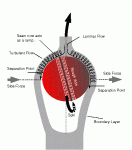R
ricky123
Guest
B) Reverse Swing
With a turbulent boundary layer on both sides of the ball, the effect of the seam is reversed. It now acts as a ramp, pushing the turbulent air away from the ball and causing the boundary layer to peel away sooner. That makes the pressure on that side higher, forcing the ball to swing towards the batsman.
To get reverse swing with a new ball, smooth on both sides, experiments show that the bowler has to reach 80-90 miles per hour to get appreciable movement. This kind of speed has only ever been achieved consistently by a few bowlers. A scuffed ball however can generate substantial reverse swing at speeds well within the capabilities of any medium-paced bowler.
The ideal ball for reverse swing has one side rough, the other smooth, with a prominent seam in between. The seam should be angled at about 15 degrees to the direction of flight, pointing away from the desired direction of movement. The ball can then be swung both into and away from the batsman depending solely on which side of the ball is delivered at the front - generating either normal or reverse swing. Because the bowler does not need to change either his grip or his action, the batsman will have no clue which way the ball is likely to move.
For reverse swing the amount of sideways movement is related to the speed of delivery, making this a particularly effective delivery for fast bowlers.
if u understand all this ,give me some tips in a easy method
With a turbulent boundary layer on both sides of the ball, the effect of the seam is reversed. It now acts as a ramp, pushing the turbulent air away from the ball and causing the boundary layer to peel away sooner. That makes the pressure on that side higher, forcing the ball to swing towards the batsman.
To get reverse swing with a new ball, smooth on both sides, experiments show that the bowler has to reach 80-90 miles per hour to get appreciable movement. This kind of speed has only ever been achieved consistently by a few bowlers. A scuffed ball however can generate substantial reverse swing at speeds well within the capabilities of any medium-paced bowler.
The ideal ball for reverse swing has one side rough, the other smooth, with a prominent seam in between. The seam should be angled at about 15 degrees to the direction of flight, pointing away from the desired direction of movement. The ball can then be swung both into and away from the batsman depending solely on which side of the ball is delivered at the front - generating either normal or reverse swing. Because the bowler does not need to change either his grip or his action, the batsman will have no clue which way the ball is likely to move.
For reverse swing the amount of sideways movement is related to the speed of delivery, making this a particularly effective delivery for fast bowlers.
if u understand all this ,give me some tips in a easy method


